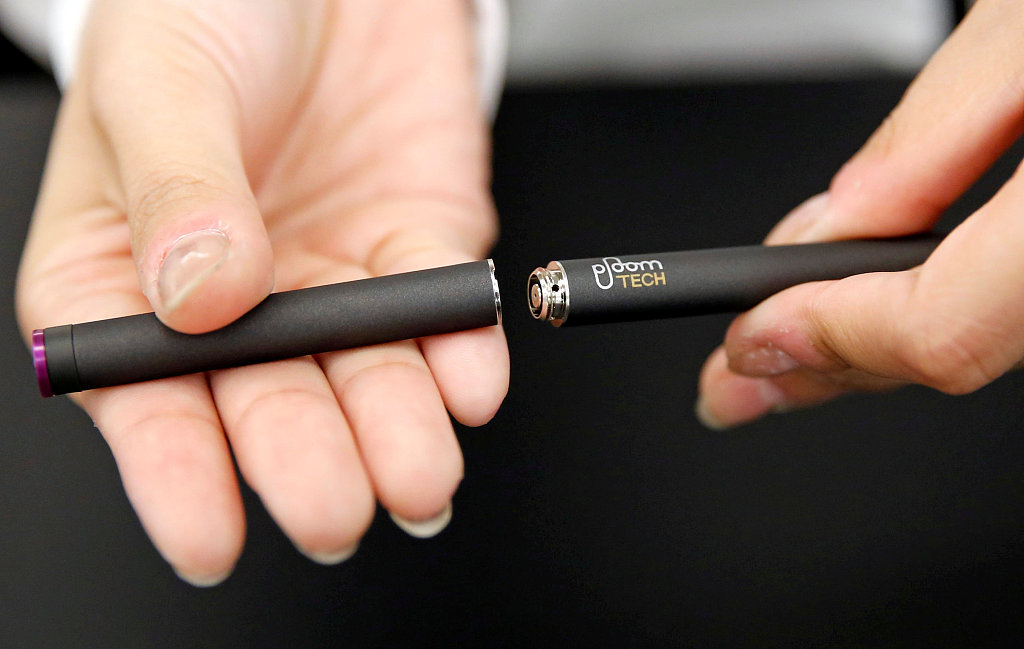

Steaming mist, tantalizing fruity flavors and attractive sleek appearances, electronic cigarettes have gained massive popularity among the young people around the world, this despite multiple reports of vaping-related deaths in the United States.
A fifth vaping-related death was reported in the U.S. on Monday.
The truth remains that e-cigarettes were invented by business, not medicine. Philip Morris USA, British American Tobacco, Japan Tobacco and Imperial Tobacco are the four leading companies in the global tobacco industry, and their profits in traditional cigarettes have declined in the past decade.
China, of course, is not untouched, the country's traditional tobacco industry experienced a downfall of 11.7 percent in 2016, and profits have been sluggish since 2013.
The upgrade of the global tobacco industry is inevitable and all four companies have shifted their focus to new-age tobacco products, like e-cigarettes.
Youth, main consumption group of e-cigarettes

E-Liquids with various flavors, which are used for vaping in electronic cigarettes, are on sale at the Smoke Depot in Chicago, Illinois, September 13, 2018. /VCG Photo
With rising global popularity and industrial upgrade, the use of e-cigarettes among the youth has begun hammering nerves of most parents and schools.
In the U.S., current e-cigarette usage among high school and middle school students increased from 2.1 percent (280,000 students) in 2011 to 25.7 percent (3.62 million students) in 2018, according to a research by the Centers for Disease Control and Prevention. The Journal of the American Medical Association said that USB flash drive-shaped e-cigarettes, such as JUUL, can be used discreetly. These products contain high nicotine content and since they are available in different flavors it is more appealing to the youth.
JUUL, a world-famous Silicon Valley startup, has taken over three-quarters of the U.S. e-cigarette market and its marketing tactics "were patently youth-oriented."
The brand reaches the youth through social media, a platform where American middle and high school students spend most of their free time. The company also hires social media influencers on Instagram and Facebook to promote its products, and the content of its blast-out colorful ads features happy, playful 20-something models enjoying vaping or performing vape tricks. Round-the-clock social media promotion and planted advertisements in music and movie events ensure that the youth are constantly exposed to the company's marketing strategy.

A JUUL advertisement features happy, attractive 20-something model displaying an e-cigarette product. /Courtesy of Stanford Research Into the Impact of Tobacco Advertising
The situation in China is equally alarming. Today more and more young people, including students, are aware of the existence of e-cigarettes, many of them are even regular users. Many worry that the initial mission of e-cigarettes, which was helping adult smokers quit smoking, has backfired.
According to a report by the Chinese Center for Disease Control and Prevention in 2018, the percentage of e-cigarette users among young people, aged between 15 and 24, is 1.5 percent, the figure is unprecedented since the entire population of young smokers accounts for 6.9 percent of the total smokers in the country.
The research found that by 2018 more young smokers had either used e-cigarettes or heard about them as compared to 2015.
The Thematic Household Survey Report No. 64, which was conducted in China's Hong Kong Special Administrative Region, pointed out that 8.7 percent high school and middle school students used e-cigarettes in 2018, while the figure was 1.4 percent among elementary school students.
Generation Z has become the main consuming group of e-cigarettes in China. The group, born after 1995, is numbered at 378 million, out of which 30 million people are working and have the purchasing power to use e-cigarettes. Many companies believe the market potential is huge and have scrambled to invest in the industry, hoping it to be the next "flying turkey" in the hurricane.
Biggest consuming market vs. biggest production base

A promoter of an e-cigarette company performs vape tricks at the Beijing International Consumer Electronics Expo, June 28, 2019. /VCG Photo
Li Wei works for an e-cigarette trading company, based in Dongguan, south China's Guangdong Province, one of the major cities producing electronic devices. He told CGTN that young people are the main target group of their products.
"E-cigarette is a new thing in China. Young people are more likely to accept it. It represents a kind of fashion trend, and even a career. You can do various tricks with the device, like blowing smoke rings," said Li.
He also noted that their products are mainly exported to North America and European countries, since domestic consumption is still very limited, and promoting e-cigarettes in China is difficult.
"Not many smokers in China accept e-cigarettes. Most of them still rely heavily on regular cigarettes, because they like the burning smell of cigarettes. E-cigarettes don't have the burning smell. It relies on steaming," Li said.
China is the world's biggest production center of e-cigarettes, accounting for over 90 percent of the global e-cigarette production, while over 90 percent of China-made cigarettes are exported to developed countries and only a small portion, accounting for less than five percent is sold domestically.
"At present, the e-cigarette market is mainly active in Western countries, among which the U.S. is leading the market of e-cigarette consumption, accounting for 49 percent of the global consumption, followed by the United Kingdom (15 percent), Italy (seven percent), Malaysia (seven percent), France (five percent) and Germany (five percent)," Wang Qinglin, analyst at iiMedia Research, a data mining and analysis organization for new economic industries, told CGTN.
Despite the current status, Wang said the market in Asia Pacific countries, including China and India will grow at a higher compound annual rate, and it's expected that the Asia Pacific market will account for nearly 30 percent of the global e-cigarette market by 2025.
Global health concerns call for govt. oversight

A shop assistant demonstrates a Japan Tobacco Inc's Ploom Tech smokeless vaping product at its Ploom Shop in Tokyo, Japan, June 28, 2017. /VCG Photo
Amid the explosive popularity of e-cigarettes among young people, global health concerns are also emerging, with many organizations around the world conducting researches on the side-effects of e-cigarettes and governments worldwide framing policies to curb its use among the youth and regulate the e-cigarette markets.
Many researches have claimed that there is no evidence to suggest that e-cigarettes were designed to promote a smoking-free society. On the contrary, according to a WHO report, these products have increased the number of young smokers, claiming that vaping could be more dangerous than smoking. As of September 2019, five vaping-related deaths and over 450 possible cases of serious lung injuries related to vaping have been reported in the United States.
Smoking can cause life-threatening diseases like heart failure and lung cancer, but it takes decades for a regular smoker to develop these conditions. However, vaping could cause seizures and serious lung damage after just a year, in some cases this time could be less than a year, according to the Centers for Disease Control and Prevention. This is because other than containing nicotine, which is addictive, e-cigarettes also include other harmful substances, like antifreeze, formaldehyde and benzene, which are well-known carcinogens.
Even the American Chemical Society at its 2018 annual meeting pointed out that vaping could cause DNA damage, eventually leading to cancer.
Due to increasing health concerns, governments of many countries have stepped in and initiated a debate to amend their legislation to manage the e-cigarette market.
"E-cigarettes are completely banned in 32 countries and regulated in 69 other countries," China Business Network quoted Sun Jiani, technical officer at the WHO's Tobacco Free Initiative in China, as saying.
On Wednesday, U.S. President Donald Trump said that the federal government plans to pull all e-cigarette flavors from the market, citing growing concerns about health hazards.
In 2016, the U.S. Department of Transportation banned the use of e-cigarettes on commercial flights. San Francisco banned the sale of e-cigarettes in June this year, and Michigan banned flavored e-cigarettes last week.
Other than the U.S., Japan has banned e-cigarettes containing nicotine. Thailand, Cambodia, Lebanon, the Philippines, Vietnam, as well as Argentina and Brazil have imposed complete bans on the devices.
The Chinese mainland banned the sale of e-cigarettes to teenagers last year. China's eastern coastal city of Hangzhou also banned the use of e-cigarettes in non-smoking zones while Shenzhen is accelerating to amend its local law to ban the use of e-cigarettes in public buildings. China's Hong Kong Special Administrative Region and Taiwan are also mulling a complete ban on manufacture, import, sale and advertising of e-cigarettes.

China's National Health Commission holds a meeting to discuss legislations to supervise the e-cigarette market, July 22, 2019. /Xinhua Photo
As scrutiny intensifies, what is the future of the e-cigarette industry?
Wang believes China's e-cigarette market will keep maintaining the current good prospect as young, high-income and well-educated people will become the largest potential consuming group in the future since many e-cigarette enterprises are making more efforts in strengthening their technology, and creating a healthy and environment-friendly image for e-cigarettes.
It's ironical that the upgrade of vaping industry and popularity of vaping culture have evolved faster than any "health-regulating" product. Companies which initially promoted their vaping products in the name of heath eventually ended up hooking more young people, even kids, to vaping at an early age.

Copyright © 2018 CGTN. Beijing ICP prepared NO.16065310-3
Copyright © 2018 CGTN. Beijing ICP prepared NO.16065310-3